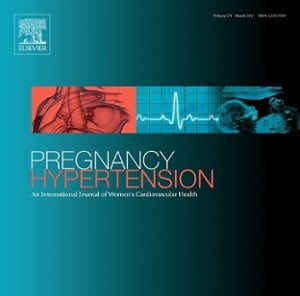Proven Clinical Outcomes & Efficacy
Babyscripts takes a research-driven approach to product development and partners with clinicians to ensure acceptance and applicability. Explore our research portfolio below for more on the value of our remote patient monitoring solutions and patient-centered mobile app.
Featured Outcomes

MCN, The American Journal of Maternal/Child Nursing
Postpartum Remote Blood Pressure Monitoring Using a Mobile App in Women with a Hypertensive Disorder of Pregnancy
March 2024

GREEN JOURNAL OBSTETRICS & GYNECOLOGY
Remote Monitoring Compared With In-Office Surveillance of Blood Pressure
September 2023

GREEN JOURNAL OBSTETRICS & GYNECOLOGY
MIND Study Midpoint Analysis: Compliance Rate of Antenatal Screening
May 2023

GREEN JOURNAL OBSTETRICS & GYNECOLOGY
Pregnancy-Related Hypertension: Adherence to a New Type of Monitoring
May 2022

WILEY ONLINE LIBRARY
Remote Gestational Weight Gain Monitoring in a Large Low-Risk US Population
August 2021

PREGNANCY HYPERTENSION
Using m-Health Apps to Diagnose Hypertension in Pregnancy
October 2020

GREEN JOURNAL OBSTETRICS & GYNECOLOGY
Connected Health-Enabled Remote Blooding Pressure Monitoring of Low-Risk Pregnancy in Rural Setting
April 2020

AMERICAN JOURNAL OF OBSTETRICS & GYNECOLOGY (AJOG)
Remote Self-Monitoring of Perinatal Weight and Perinatal Outcomes in Low-Risk Women
February 2020

JOURNAL OF MEDICAL INTERNET RESEARCH
Effectiveness of a Mobile Prenatal Care App to Reduce In- Person Visits: A Prospective Trial
May 2019

GREEN JOURNAL OBSTETRICS & GYNECOLOGY
Early Detection and Intervention of Postpartum Preeclampsia With the Use of Mobile and Digital Tools
May 2019

AMERICAN JOURNAL OF OBSTETRICS & GYNECOLOGY (AJOG)
Does Remote Monitoring of Blood Glucose Levels During Pregnancy Expedite Time to Intervention?
May 2019

GREEN JOURNAL OBSTETRICS & GYNECOLOGY
Evaluation of Antepartum and Postpartum Remote Blood Pressure Monitoring in Low-Risk Pregnancy
May 2019

GREEN JOURNAL OBSTETRICS & GYNECOLOGY
Evaluating Technology-Enabled Care Coordination During Prenatal Care for an Underserved Population
May 2018

GREEN JOURNAL OBSTETRICS & GYNECOLOGY
Evaluating Patient Satisfaction and Experience for Technology-Enabled Prenatal Care for Low Risk Women
May 2018

GREEN JOURNAL OBSTETRICS & GYNECOLOGY
Evaluation of Antepartum and Postpartum Remote Monitoring of Gestational Weight Gain in Low-Risk Pregnancy
May 2018

GREEN JOURNAL OBSTETRICS & GYNECOLOGY
Blood Pressure Trends in Pregnancy: Is There a New Normal?
May 2017

JOURNAL OF MEDICAL INTERNET RESEARCH
Testing the Feasibility of Remote Patient Monitoring in Prenatal Care Using a Mobile App and Connected Devices: A Prospective Observational Trial
November 2016

GREEN JOURNAL OBSTETRICS & GYNECOLOGY
Remote Prenatal Care Monitoring With Digital Health Tools Can Reduce Visit Frequency While Improving Satisfaction
May 2016

GREEN JOURNAL OBSTETRICS & GYNECOLOGY
Preventing Excessive Gestational Weight Gain By Using Connected Weight Scales Paired With Mobile Apps
May 2016

GREEN JOURNAL OBSTETRICS & GYNECOLOGY
A Resource and Cost Analysis on the Impact of Reduced Visits for Prenatal Care
May 2016

GREEN JOURNAL OBSTETRICS & GYNECOLOGY
Remote Capture and Monitoring of Clinical Data During Pregnancy
May 2015
Challenging Conventional Wisdom
The current structure of pregnancy care began with the issuance of the IOM study in 1985, which called for increased prenatal visits as a mechanism to reduce low birth weight. Yet 35 years later, though the number of visits has increased, the rate of low birth weight babies has not decreased. Furthermore, the rising rates of maternal mortality and morbidity in the US manifest the inadequacy of current structures of care to protect mothers, especially the minority and low-income women who comprise the majority of these statistics.
A Changing Landscape
What's the key takeaway? In most developed countries, the reduced frequency of visits did not show a statistically significant difference in maternal and fetal outcomes.
However, a reduction in visits could potentially impact patient satisfaction and Provider-patient intimacy. Several programs have been created to augment a reduced visit schedule to maintain or increase patient satisfaction for low-risk pregnancies. These programs include group prenatal care (or Centering), which uses physician helpers in group prenatal care for low-risk patients, and OB Nest program implemented at the Mayo Clinic.
An additional review of alternative schedules can be found in a control study found here, as well as a study conducted by Kaiser.
Remote Monitoring Compared With In-Office Surveillance of Blood Pressure in Patients With Pregnancy-Related Hypertension
Remote monitoring through Babyscripts eliminated disparity in capture between Black and White patients and raised the rate of ascertainment for both groups.
Pregnancy-Related Hypertension: Adherence to a New Type of Monitoring
Babyscripts remote patient monitoring solution can increase postpartum blood pressure ascertainment within 10 days of discharge for patients with hypertensive disorders of pregnancy.
Remote Gestational Weight Monitoring Can Increase IOM Adherence
High engagement with the Babyscripts maternal health app increased adherence to the Institute of Medicine (IOM) gestational weight gain guidelines and increased postpartum weight loss.
Using m-Health Apps to Diagnose Hypertension in Pregnancy
How the Babyscripts remote patient monitoring solution facilitates earlier risk identification and intervention by detecting asymptomatic, elevated blood pressures in pregnancy.
